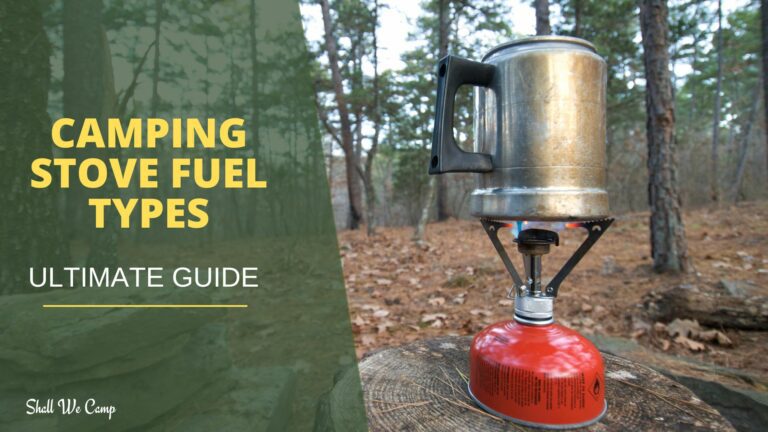Whether you’re boiling water for coffee in the morning or cooking up a hearty dinner after a long hike, the fuel you choose for your camping stove plays a big role in your overall experience.
For instance, a fuel that’s easy to light and burns steadily will save you time and hassle, letting you focus on enjoying your trip. On the other hand, the wrong fuel can leave you struggling with a stove that won’t cooperate, especially if the weather isn’t on your side. That’s why understanding the different types of camping stove fuels is so important.
According to a recent Outdoor Industry Association report, a staggering 48% of campers have experienced fuel-related issues during their trips. Don't let that be you.
Certain fuels perform better in cold temperatures, while others are ideal for warmer conditions. Availability is another big thing to consider. Some fuels are easy to find almost anywhere, while others might be harder to track down depending on where you’re camping. And of course, you’ll need to make sure the fuel is compatible with your stove, as not all stoves can handle every type of fuel.
Affiliate Disclaimer: This site contains affiliate links, which means I may earn a commission on purchases made through these links at no extra cost to you.
Table of Contents
Overview of Common Camping Stove Fuel Types
There’s no one-size-fits-all solution when it comes to camping stove fuels. Each type of fuel has its own strengths and weaknesses, and the best choice for you will depend on your specific needs and camping style. Let’s take a closer look at some of the most common types of camping stove fuels and what they bring to the table.
Propane
Propane is a go-to option for many campers, because of how simple they are to use. You just screw one onto your stove, and you’re ready to cook. Plus, propane is widely available, so you can pick up a canister at most outdoor stores, gas stations, or even some grocery stores. Another big plus is that propane performs well in cold weather, maintaining a steady flame even when the temperature drops.

However, there are a couple of downsides. Propane canisters are on the heavier side, which isn’t ideal if you’re backpacking and need to keep your load light. They’re also not refillable, so once the fuel runs out, you’ll need to pack out the empty canister and replace it with a new one. That said, propane is a fantastic choice for car camping or short trips where weight isn’t a big concern.
Using Propane:
- Attach the canister to your stove (it usually just screws on).
- Turn the valve.
- Light it up and start cooking! No priming, no pumping, no fuss.
Types of camping stoves that use propane:
- Tabletop stoves: These often have two burners for whipping up feasts.
- Portable single-burner stoves: Great for backpacking or minimalist campers.
- Hybrid stoves: Some clever designs can use both propane and butane.
- High-pressure propane stoves: These can typically handle larger pots and even deep frying
Shall We Camp Tip: To maximize efficiency, always cook with a lid on your pot. You'll use less fuel and cook faster
Butane
Butane is another popular fuel option, especially for those looking to keep things light and portable. The canisters are more compact and lighter than propane, making them easier to pack if you’re heading out on a backpacking trip. They’re also straightforward to use… just click a butane canister into place, and you’re good to go.
Butane does have its limitations, however. It doesn’t perform as well in cold weather, so if you’re camping in cooler temperatures, you might find it harder to get a consistent flame. Additionally, butane can be a bit trickier to find, especially if you’re in a more remote area.
Popular butane stove models:
- MSR PocketRocket 2
- Soto Windmaster
- Snow Peak LiteMax
- Jetboil MiniMo
Shall We Camp Tip: If you're camping in cooler climates, try sleeping with the canister in your sleeping bag. Your body heat can help keep it warm enough to function.
Isobutane
Isobutane is like butane but slightly more versatile. It offers better performance in cold weather, making it a good choice for three-season camping. Isobutane canisters are similar in size and weight to butane, so they’re still lightweight and easy to pack. They’re also user-friendly, as you just need to attach the canister to your stove and start cooking.

The main downside to isobutane is that the canisters are disposable, which means you’ll need to carry out the empties and find new ones when you run out. Availability can also be hit or miss, depending on where you’re camping. But for those looking for a fuel that works well in a variety of conditions, isobutane is a great middle-ground option, especially for backpackers.
Canister stove designs:
- Integrated canister stoves: All-in-one systems like the Jetboil or MSR Windburner.
- Remote canister stoves: The fuel canister sits to the side, providing a more stable cooking platform.
- Micro stoves: Tiny titans like the BRS-3000T.
- Inventor stoves: Clever designs that let you invert the canister for better cold-weather performance and to use every last drop of fuel.
White Gas (Liquid Gas)
White gas, also known as liquid gas, is a favorite among experienced campers and adventurers who need reliable performance in all types of weather. This fuel is known for its high heat output, making it perfect for boiling water quickly or cooking in cold conditions. Also, white gas is refillable, which is great if you’re on a longer trip and don’t want to carry a bunch of disposable canisters.

The main drawback of using white gas is that it requires a bit more effort to use. You’ll need to prime your stove before lighting it, which can be a bit of a struggle if you’re not used to it. There’s also more maintenance involved, as liquid fuel stoves need to be cleaned regularly to keep them running smoothly.
White Gas Best Practices:
- Priming is key: White gas stoves need priming for optimal performance.
- Keep it clean: Regular maintenance of your stove prevents clogs and ensures efficient burning.
- Spills happen: Always fill your fuel bottle away from your cooking area.
- Proper storage: Use only approved fuel bottles.
- Ventilation: Like all fuels, use white gas stoves in well-ventilated areas.

Alcohol
For ultralight backpackers and minimalists, alcohol stoves are a top choice. The fuel is lightweight and easy to find. You can use denatured alcohol, ethanol, or even methanol. Alcohol burns cleanly, so you won’t have to worry about soot buildup on your pots and pans. Plus, alcohol stoves are often super simple and low-cost, making them a great option for those looking to keep things basic.
However, alcohol doesn’t produce as much heat as other fuels, which means cooking times can be longer. This can be a downside if you’re in a hurry to get your meal ready after a long day on the trail.
Best scenarios for using alcohol stoves:
- Ultralight backpacking: When every gram counts, and simplicity is key.
- Budget travel: Perfect for globetrotters watching their pennies.
- Emergency preparedness: A reliable, shelf-stable fuel option for your bug-out bag.
- Short trips: Ideal for weekend warriors who don't need extended burn times.
- Warm weather camping: When you don't need to melt snow for water.
Shall We Camp Tip: Alcohol stoves shine in situations where you're mainly boiling water for dehydrated meals or making coffee.
Wood
For those who love the idea of cooking with a natural fuel source, wood-burning stoves offer a unique and rewarding experience. With a wood stove, you don’t need to carry fuel with you, because you can just gather twigs, branches, or other dry wood from your surroundings, and you’re ready to cook. This can be a big plus if you’re camping in an area with plenty of available wood.

Of course, sometimes finding dry wood can be challenging, especially if it’s been raining, and not all areas allow wood fires due to fire bans or environmental regulations. But if you’re camping in a location where wood fires are permitted and you’re prepared to put in a little extra effort, a wood stove can provide a satisfying and sustainable way to cook your meals.
Techniques for efficient wood burning:
- Size: Use small, dry twigs and branches.
- Air flow: Arrange your wood to allow for good air circulation.
- Prep your tinder: Dry bark, pine needles, or even dryer lint can help get things started.
- Feed the flame: Add wood gradually.
- Patience: Let your wood burn down to hot coals for the most efficient cooking heat.
Popular wood stove models and features:
- Solo Stove Lite
- BioLite CampStove 2+
- Emberlit Fireant
- Vargo Hexagon
Factors to Consider When Choosing Stove Fuel

Choosing the right stove fuel involves finding the fuel that fits your specific camping conditions and needs. As we already mentioned, some fuel types perform better (or worse) in certain weather conditions. So let’s talk about some of the things you should consider when deciding which fuel to bring on your next outdoor adventure.
1. Climate and Weather Conditions
The climate and weather where you’ll be camping can have a big impact on how well your stove fuel performs. For example, propane and white gas are known for their reliability in cold weather, making them great choices if you’re camping in winter or at higher elevations. Butane, on the other hand, can struggle to vaporize in colder temperatures, leading to weak flames or difficulty in lighting the stove.
Altitude is another important consideration. At higher elevations, the air pressure is lower, which can affect how efficiently some fuels burn. White gas and isobutane are typically better suited for high-altitude cooking, while other fuels might require more time to boil water or cook food.
2. Trip Duration and Type
Trip Duration:
For short trips, you might prioritize convenience and ease of use. Fuels like propane and butane, which come in compact canisters, are ideal for a quick weekend getaway where you don’t need to worry about carrying too much.
For extended stays, however, fuel efficiency and the ability to replenish your supply become more important. White gas is a popular choice for longer trips because it’s refillable and burns efficiently, meaning you can carry a larger amount of fuel without needing multiple canisters.
Alcohol stoves, while slower to cook, are also a good option for long trips due to the lightweight nature of the fuel.
Type of Trip:
Car campers can afford to carry heavier fuels like propane, while backpackers need to consider weight and might opt for lighter options like alcohol or isobutane.
3. Availability and Accessibility
Availability of fuel can vary depending on where you’re camping, so it’s important to plan ahead. Some fuels, like propane, are widely available across the country, making them a safe bet if you’re traveling through multiple regions or unsure of local supply.
Butane and isobutane, while popular, can be harder to find in more remote areas. If you’re heading off the beaten path, it’s wise to check in advance whether these fuels will be available at your destination or if you need to bring enough with you.
4. Environmental Impact
As campers, we all want to minimize our impact on the environment, and the type of fuel you choose can play a part in that. Some fuels are more eco-friendly than others.
For example, alcohol stoves burn cleanly and produce minimal waste, making them a greener option. Wood stoves can also be environmentally friendly, especially if you’re using fallen branches and twigs instead of cutting down live trees.
On the other hand, fuels like propane and butane come in single-use canisters that need to be disposed of properly. If you choose these fuels, it’s important to follow Leave No Trace principles by packing out empty canisters and recycling them where possible.
Check out this article on the 10 Must-Have Camping Cookware for Outdoor Cooking. It's packed with essential gear recommendations to make your camping meals even more delicious and hassle-free!








